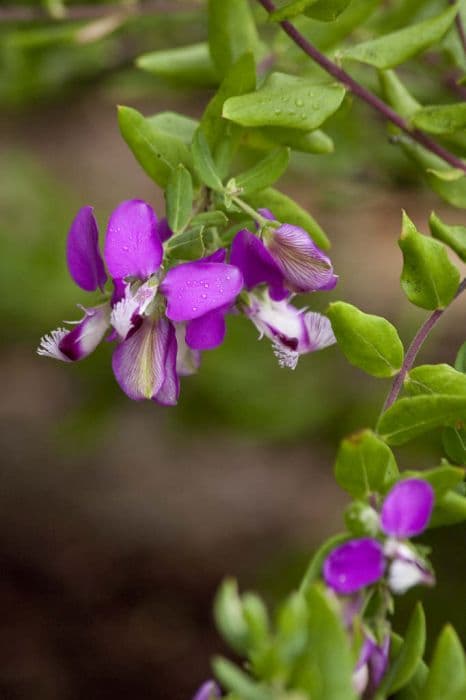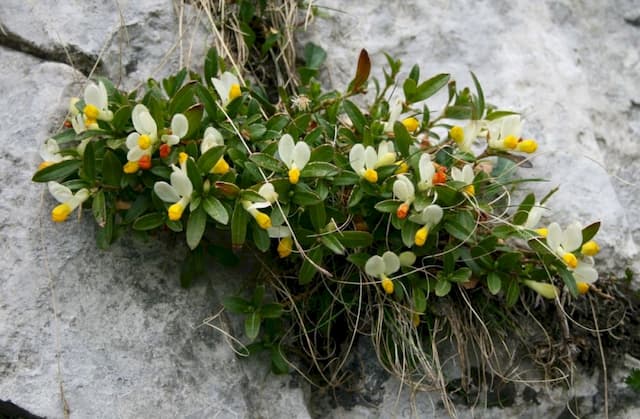Shamrock Pea Polygaloides chamaebuxus 'Loibl'

ABOUT
The plant known as Polygaloides chamaebuxus 'Loibl', commonly referred to as "shrub milkwort," features a low-growing, spreading habit that makes it a popular choice for ground cover. Its leaves are small, glossy, and evergreen, providing year-round interest in the garden. The foliage often takes on a leathery texture and may exhibit shades of green that can vary in intensity throughout the seasons. The most striking feature of the shrub milkwort is its flowers. They bloom profusely in the spring, displaying a charming color palette that ranges from creamy yellow to purple. The individual blooms resemble miniature pea flowers, typical of plants in its family, and are often bicolored, with a yellow or white backdrop and a contrasting purple to violet center. The flowers are accompanied by small, inconspicuous fruits later in the growing season.
About this plant
 Names
NamesFamily
Polygalaceae
Synonyms
Boxleaf Milkwort, Dwarf Milkwort, Shrubby Milkwort
Common names
Polygala chamaebuxus 'Loibl', Polygala chamaebuxus var. loibl.
 Toxicity
ToxicityTo humans
Boxleaf Milkwort is known to contain saponins, which are toxic chemicals that can lead to gastrointestinal issues if ingested. Symptoms of poisoning from consumptions of parts of the Boxleaf Milkwort may include nausea, vomiting, stomach ache, and diarrhea. In severe cases, the saponins can cause hemolysis, which is the breakdown of red blood cells. It is important to avoid ingesting the plant to prevent the potential toxic effects.
To pets
Boxleaf Milkwort is also toxic to pets due to its saponin content. If a pet ingests parts of this plant, it may experience symptoms similar to those in humans, such as gastrointestinal upset characterized by vomiting and diarrhea. In severe cases, more serious symptoms like lethargy, abdominal tenderness, and hemolysis could occur. Pet owners should keep their animals away from the plant to avoid accidental ingestion and possible poisoning.
 Characteristics
CharacteristicsLife cycle
Perennials
Foliage type
Evergreen
Color of leaves
Green
Flower color
Yellow
Height
1 foot [30 cm]
Spread
2 feet [60 cm]
Plant type
Shrub
Hardiness zones
5
Native area
Europe
Benefits
 General Benefits
General Benefits- Low maintenance: The plant is well-suited to low-maintenance gardens, as it does not require frequent care once established.
- Drought tolerance: Once established, it possesses a good tolerance to dry conditions, reducing the need for regular watering.
- Ground cover: It serves as an effective ground cover, reducing weed growth and preventing soil erosion.
- Attracts pollinators: It attracts bees and other pollinating insects, supporting biodiversity in the garden.
- Evergreen foliage: It retains its leaves throughout the year, providing persistent greenery in the garden landscape.
- Decorative flowers: It produces vivid flowers, which add aesthetic appeal to garden spaces.
- Rock gardens: It is particularly suitable for rock gardens due to its compact size and growing habit.
- Edging plant: Its small and neat growth habit makes it ideal for use as an edging plant along borders or pathways.
- Variegated varieties: Some cultivars have variegated foliage that adds a splash of color and visual interest to the garden.
- Cold hardy: The plant can withstand cold temperatures, making it suitable for gardens in cooler climates.
- Adaptability: It can adapt to a range of soil types, though it prefers well-draining soils.
- Container gardening: It can be grown in containers, allowing for versatility in garden design and the ability to move the plant as needed.
 Medical Properties
Medical PropertiesThis plant is not used for medical purposes.
 Air-purifying Qualities
Air-purifying QualitiesThis plant is not specifically known for air purifying qualities.
 Other Uses
Other Uses- Polygaloides chamaebuxus 'Loibl', commonly known as Box-leaved Milkwort, can be used as inlay work material for its fine, dense foliage that provides a unique texture.
- Box-leaved Milkwort can serve as a natural carpet in miniature fairy gardens or model landscapes due to its low-growing, mat-forming habit.
- The flowers of Box-leaved Milkwort can be used in small-scale floral arrangements and decorative boutonnieres owing to their delicate and intricate appearance.
- This plant can be used in bonsai arrangements, as it tolerates pruning well and can be shaped over time.
- Box-leaved Milkwort may be used as a living mulch to cover bare soil in garden beds, helping to retain soil moisture and suppress weeds.
- Its dense mats provide a unique green roofing material for covering birdhouses or small garden structures.
- Box-leaved Milkwort can be placed in crevices of rock walls or stone paths, adding greenery and beauty to hardscaped areas.
- The plant can also serve as an edge plant in themed gardens, such as gnome or elfin gardens, due to its small size and enchanting flowers.
- Box-leaved Milkwort can be placed in terrariums or bottle gardens, where its small scale complements the confined space.
- Lastly, it can be used artistically to create living sculptures or garden art when grown over forms or frames.
Interesting Facts
 Feng Shui
Feng ShuiThe plant Polygala chamaebuxus is not used in Feng Shui practice.
 Zodiac Sign Compitability
Zodiac Sign CompitabilityThe plant Polygala chamaebuxus is not used in astrology practice.
 Plant Symbolism
Plant Symbolism- Perseverance: The Polygaloides chamaebuxus, commonly known as Shrubby Milkwort, is known for its hardiness and ability to thrive in challenging conditions, symbolizing the quality of perseverance in the face of adversity.
- Fidelity: Shrubby Milkwort's faithful blooming year after year can be seen as a symbol of fidelity, representing constancy and loyalty in relationships.
- Protection: This plant is often associated with protection due to its dense growth habit, which provides shelter to small animals and insects, signifying a haven or protective embrace.
 Water
WaterFor the Shrubby Milkwort, it is essential to keep its soil consistently moist during the growing season. You should water this plant once or twice a week, depending on weather conditions, making sure to soak the soil thoroughly each time. Typically, applying about 1-2 gallons of water per week will be sufficient, but be sure to adjust for rainfall and temperature changes. During the winter, when the plant is dormant, water less frequently, allowing the soil to dry out slightly between waterings. Avoid overhead watering to prevent foliar diseases, and instead aim to apply water directly to the base of the plant.
 Light
LightShrubby Milkwort thrives best in full sun to partial shade conditions. The ideal location for this plant is a spot where it can receive at least four to six hours of sunlight daily. However, it can also tolerate dappled shade, especially in hotter climates where some relief from intense afternoon sun can be beneficial.
 Temperature
TemperatureShrubby Milkwort is quite cold-hardy and can tolerate temperatures down to about 10 degrees Fahrenheit, making it suitable for many temperate regions. It prefers a range of temperatures between 60 and 75 degrees Fahrenheit for optimal growth. Extreme heat above 90 degrees Fahrenheit should be avoided, as it may stress the plant.
 Pruning
PruningPruning Shrubby Milkwort is important to maintain its shape and promote vigorous growth. It should be pruned in the late winter or early spring before new growth starts. Trim back any dead or damaged branches and shape the plant as desired. Pruning can be done annually, but minimal pruning is generally required to keep the plant looking tidy.
 Cleaning
CleaningAs needed
 Soil
SoilShrubby Milkwort prefers well-draining soil that is rich in organic matter with a slightly acidic to neutral pH of 6.0 to 7.0. A good soil mix for Shrubby Milkwort can be created using two parts loam or garden soil, one part peat moss, and one part sharp sand or perlite to ensure adequate drainage.
 Repotting
RepottingShrubby Milkwort should be repotted every 2 to 3 years to refresh the soil and address any root crowding. Repotting is best done in the spring before the onset of the growing season.
 Humidity & Misting
Humidity & MistingShrubby Milkwort thrives best in moderate humidity levels but is quite adaptable and can tolerate the lower humidity typically found in home environments.
 Suitable locations
Suitable locationsIndoor
Place in bright, indirect light; avoid overwatering.
Outdoor
Full sun to part shade; protect from extreme cold.
Hardiness zone
5-9 USDA
 Life cycle
Life cyclePolygaloides chamaebuxus 'Loibl', commonly known as Shrubby Milkwort, begins its life cycle as a seed that germinates in the spring when soil temperatures and moisture levels are adequate. The seedling emerges and establishes a root system, followed by the growth of foliage; the plant exhibits low, spreading branches with small, evergreen leaves. In the late spring to early summer, Shrubby Milkwort produces flowers—small, yellow blooms, often with purple accents, which are pollinated by insects. After pollination, the flowers develop into capsules containing seeds that mature by late summer. As the seeds are dispersed by wind, animals, or other natural means, the parent plant continues to grow and can spread through rhizomes. The plant enters a period of dormancy during the winter months, but being evergreen, it retains its leaves, re-emerging with new growth the following spring.
 Propogation
PropogationPropogation time
Spring to summer
The most popular method of propagation for Polygaloides chamaebuxus 'Loibl', commonly referred to as Shrubby Milkwort, is through semi-hardwood cuttings. This is often done in the late summer. You would take a cutting from a healthy part of the plant that is about 4 to 6 inches (10 to 15 centimeters) in length, making sure it includes at least one or two sets of leaves. The cut end should be dipped in rooting hormone to enhance root development and then planted in a well-draining soil mixture. It's important to keep the soil moist but not waterlogged and provide a warm environment with indirect light until the cutting has rooted, which usually takes a few weeks. Once the cutting has established a strong root system, it can be transplanted to its final location.



